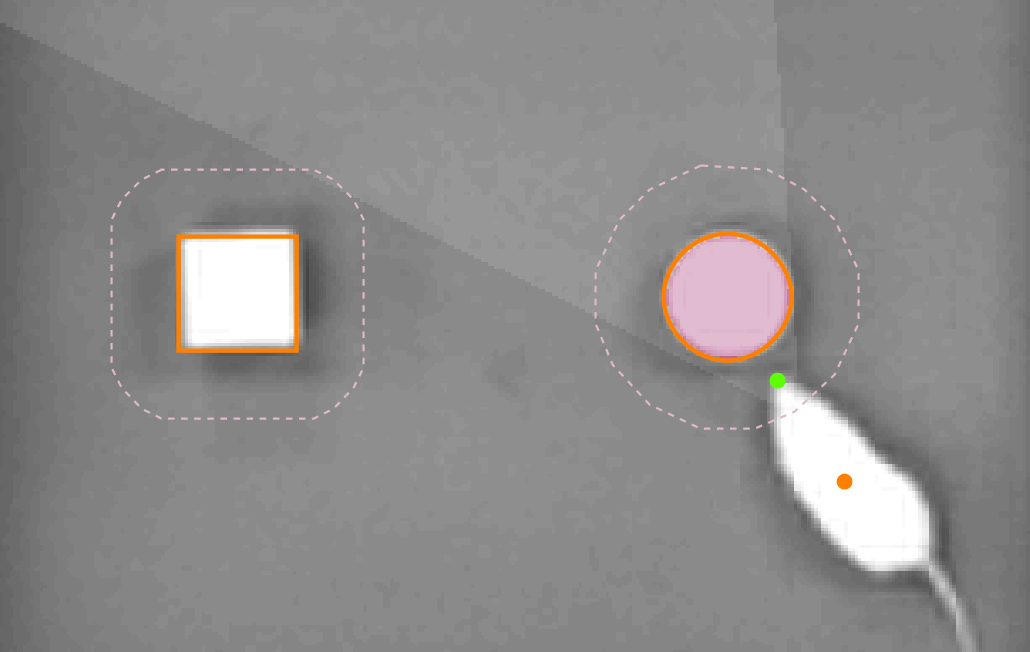Novel Object Recognition (NOR) is a popular and relatively simple behavioural assay of memory. Vital to NOR automation is tracking the animal’s head.
ANY‑maze not only tracks the position of the animal's head, but it also determines the animal's orientation, allowing you to distinguish when an animal is interacting with objects from when it is merely in close proximity to them. See the Benefits tab, below, to learn more.
On the other tabs you'll find videos of NOR in action, recommended equipment and a list of results that are especially useful in this test.
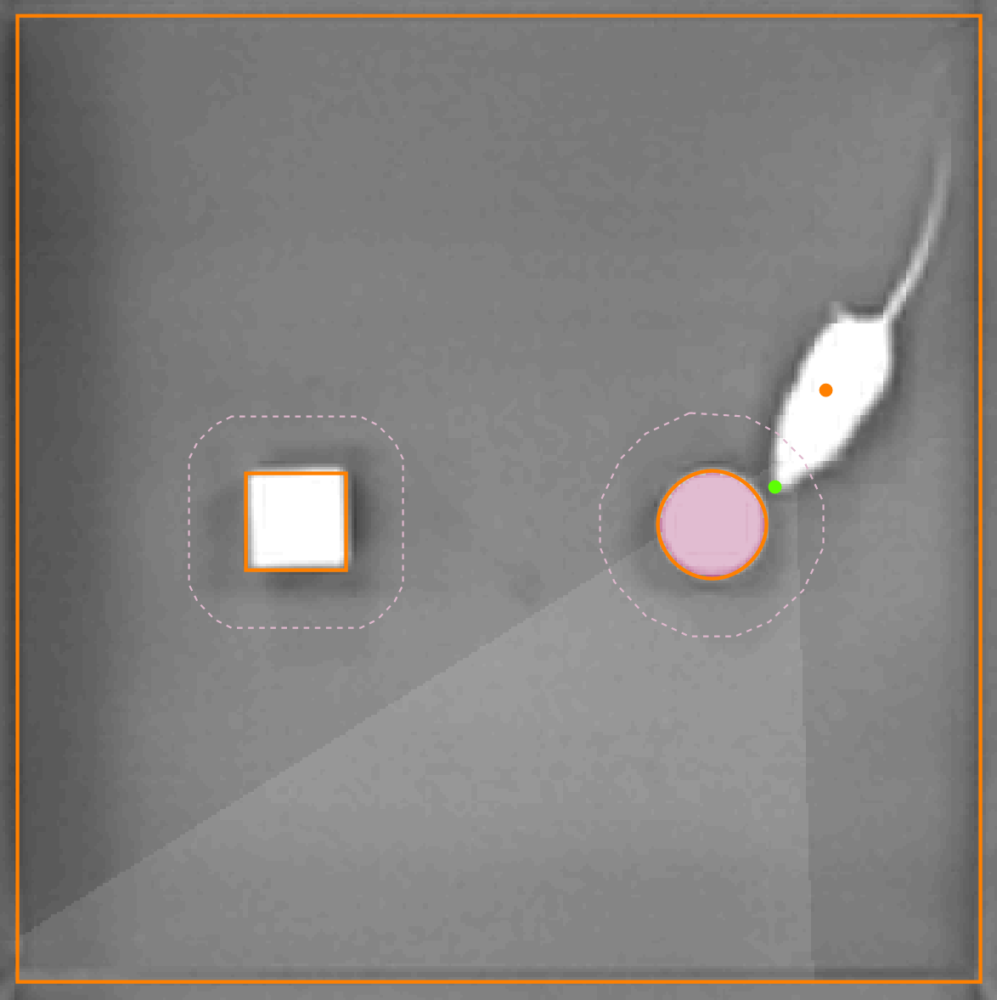
Object exploration
ANY‑maze includes Investigation zones designed specifically for tests like Novel object recognition.
To determine when an animal is exploring an object you simply draw a zone tightly around the object and specify how close to it the animal’s head must be – the dotted line in the image.
This simple approach can be improved by optionally specifying that exploration is only occurring when the animal’s head is in within this distance of the zone and it is oriented towards the centre of the zone – the flashlight-like shading in the image shows the animal’s orientation.
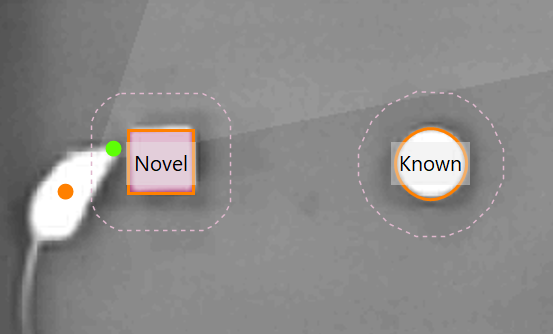
Excluding time on the object
In some cases animals can climb onto an object and some investigators prefer to exclude this from object exploration.
This can be achieved in ANY‑maze, simply by specifying that exploration is should exclude any time that the animal’s centre is within the investigation zone, i.e. the object.
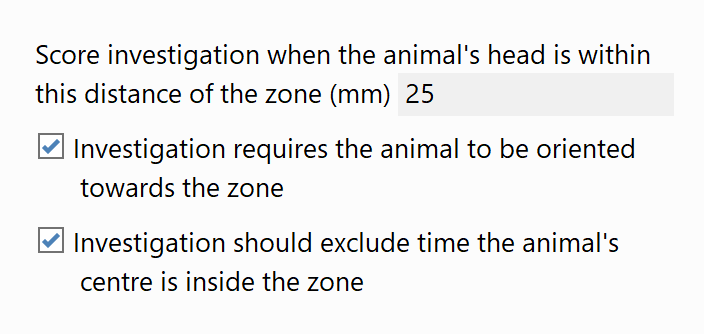
Moveable objects
It is common to move the location of the novel object so it is not in the same place for all animals. In ANY‑maze it’s easy to setup moveable zones, that can adopt different positions in different tests. You can even create relationships between moveable zones – for example, by specifying that the novel object zone is on the left in a specific test, the system will automatically know that the known object must be on the right.
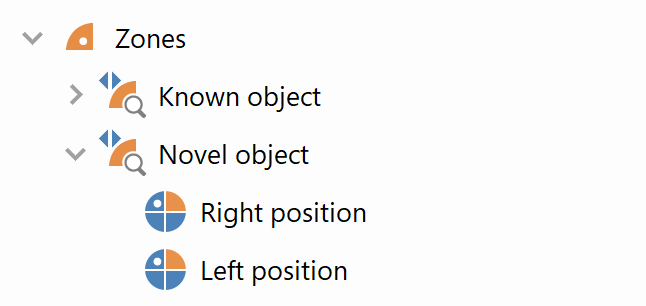
Results
ANY‑maze can provide literally hundreds of results for any test, but some of those that are particularly useful in the Novel Object Recognition test include:
- Total time exploring the novel object
- Total time exploring the known object
- Percentage of time exploring the novel object
- Percentage of time exploring the known object
- Discrimination index
- Recognition (preference) index
- Distance travelled
Novel object recognition
We manufacture our own novel object recognition test arenas , which are available for rat or mouse (the mouse version is pictured on the right). Transparent or opaque walls fit solidly into a slotted, grey, non-reflective base-plate, but lift off for easy cleaning. Objects of various shapes and colours are also available.
View more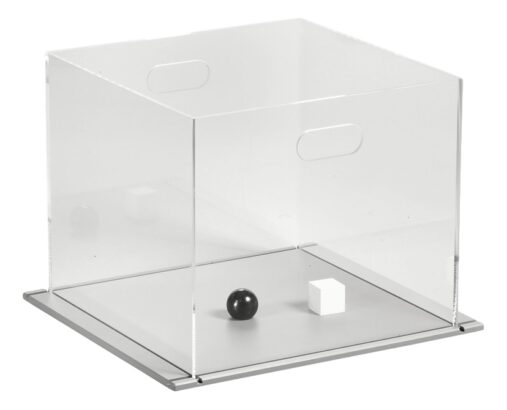
Cameras
USB camera
The ANY‑maze USB camera is an excellent choice for the novel object recognition test. We recommend fitting this camera with a varifocal (zoom) lens, so you can simply mount the camera on the ceiling and then zoom in and out until the maze nicely fits the camera's view.
View more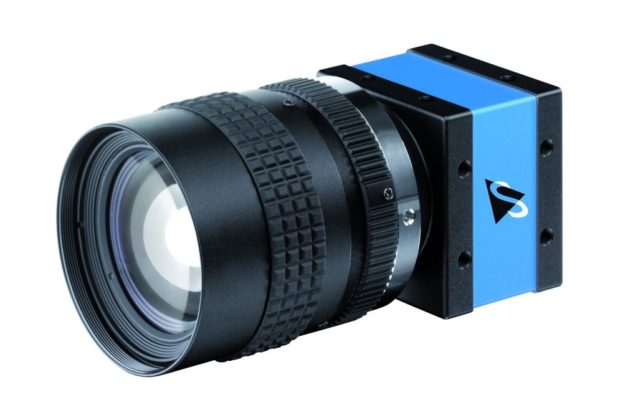
Web cam
A webcam provides an inexpensive alternative to the ANY‑maze camera. If you intend to test in normal lighting conditions (>= 100 lux) and you can mount the camera far enough from the open field for it to see it all, then a webcam should work well. Another potential issue is the cable length; most webcams have quite short cables.
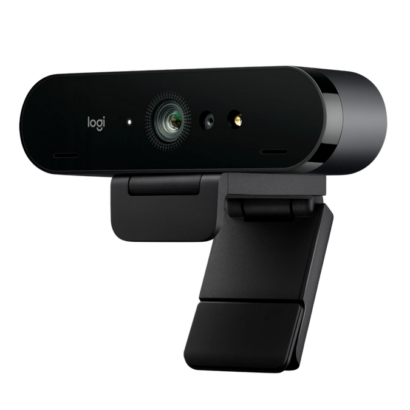
Accessories
Photobeam arrays
The ANY‑maze photobeam array provides a ‘curtain’ of photobeams which can be used to detect when an animal rears. The array plugs directly into the ANY‑maze Digital interface.
The array is available both 'standalone' and as part of the ANY-box system, which includes mounting columns, and a camera.
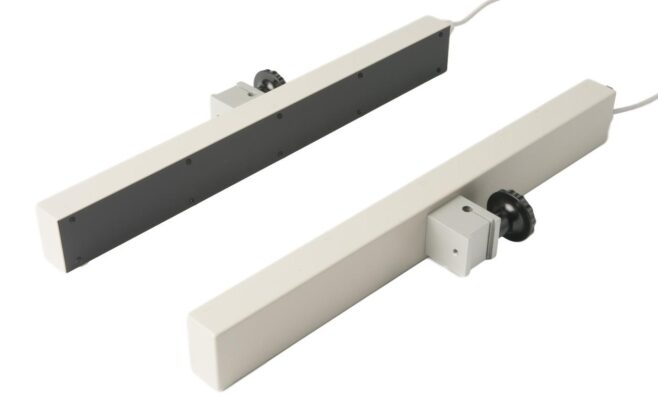
Meka, S. T., et al (2023). Novel HDAC inhibitors provide neuroprotection in MPTP-induced Parkinson’s disease model of rats. European Journal of Pharmacology, 959 (176067).
Calvo-Enrique, L., et al (2023). Enhanced TrkA signaling impairs basal forebrain-dependent behavior. Frontiers in Molecular Neuroscience, 16 (1266983).
AlHarthi, A., et al (2023). Investigating Behavioral and Neuronal Changes in Adolescent Mice Following Prenatal Exposure to Electronic Cigarette (E-Cigarette) Vapor Containing Nicotine. Brain Sciences, 13(10), 1417.
Chen, J., et al (2023). Microglia trigger the structural plasticity of GABAergic neurons in the hippocampal CA1 region of a lipopolysaccharide-induced neuroinflammation model. Experimental Neurology, 370 (114565).
Grychowska, K., et al (2023). Superiority of the Triple-Acting 5-HT6R/5-HT3R Antagonist and MAO-B Reversible Inhibitor PZ-1922 over 5-HT6R Antagonist Intepirdine in Alleviation of Cognitive Deficits in Rats. J. Med. Chem., 66, 14928-14947.
Potasiewicz, A., et al (2020). Positive allosteric modulators of alpha 7 nicotinic acetylcholine receptors enhance procognitive effects of conventional anti-Alzheimer drugs in scopolamine-treated rats. Behavioural Brain Research, 385, 112547.
Wang, H. Y., et al (2020). Huperzine A ameliorates obesity-related cognitive performance impairments involving neuronal insulin signaling pathway in mice. Acta Pharmacologica Sinica, 41(2), 145-153.
Nikiforuk, A., et al (2020). Desformylflustrabromine, a positive allosteric modulator of α4β2-containing nicotinic acetylcholine receptors, enhances cognition in rats. Pharmacological Reports, 1-11.
Souza, M. F., et al (2020). Intracerebroventricular injection of deltamethrin increases locomotion activity and causes spatial working memory and dopaminergic pathway impairment in rats. Brain research bulletin, 154, 1-8.
Pereira, A. G., et al (2020). Temporal development of neurochemical and cognitive impairments following reserpine administration in rats. Behavioural Brain Research, 383, 112517.
Yin, F., et al (2019). The basolateral amygdala regulation of complex cognitive behaviours in the five-choice serial reaction time task. Psychopharmacology, 236(11), 3135-3146.
Udobi, K. C., et al (2019). Deletion of the creatine transporter gene in neonatal, but not adult, mice leads to cognitive deficits. Journal of inherited metabolic disease, 42(5), 966-974.
Datta, S., et al (2019). Sex and estrous cycle dependent changes in locomotor activity, anxiety and memory performance in aged mice after exposure of light at night. Behavioural brain research, 365, 198-209.
Chandrakantan, A., et al (2019). Object Recognition in P14 mice. bioRxiv, 850933.
Van Can, M., et al (2018). Willughbeia cochinchinensis prevents scopolamine-induced deficits in memory, spatial learning, and object recognition in rodents. Journal of ethnopharmacology, 214, 99-105.
Haridas, S., et al (2018). Whisker dependent responsiveness of C57BL/6J mice to different behavioral test paradigms. Behavioural brain research, 336, 51-58.
Lueptow, L. M. (2017). Novel object recognition test for the investigation of learning and memory in mice. JoVE (Journal of Visualized Experiments), (126), e55718.
Arias-Cavieres, A., et al (2017). Aging impairs hippocampal-dependent recognition memory and LTP and prevents the associated RyR up-regulation. Frontiers in aging neuroscience, 9, 111.

 Setting up apparatus
Setting up apparatus Video capture & tracking
Video capture & tracking Observing behaviour
Observing behaviour Connecting equipment
Connecting equipment Automating complex tests
Automating complex tests Running tests
Running tests Results
Results Visualising data
Visualising data Analysis
Analysis Transferring data
Transferring data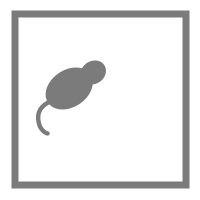 Open field
Open field Water-maze
Water-maze Y-maze
Y-maze Fear conditioning
Fear conditioning Novel object
Novel object Barnes maze
Barnes maze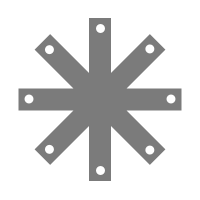 Radial arm maze
Radial arm maze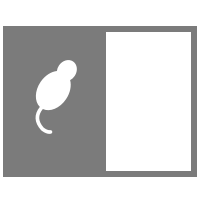 Light/dark box
Light/dark box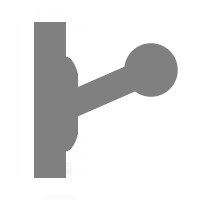 Operant conditioning
Operant conditioning Zebrafish
Zebrafish Computers
Computers Multifunction remote
Multifunction remote Accessories
Accessories Digital interface
Digital interface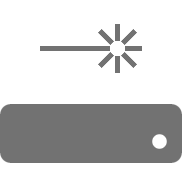 Optogenetic interface
Optogenetic interface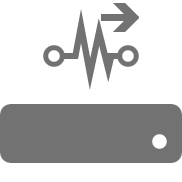 Synchronisation interface
Synchronisation interface Relay interface
Relay interface Audio interface
Audio interface Touch interface
Touch interface Analogue interface
Analogue interface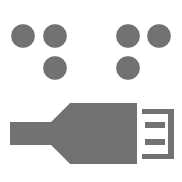 USB TTL cable
USB TTL cable Animal shocker
Animal shocker Components
Components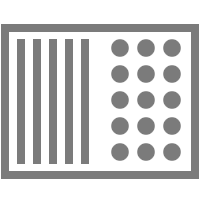 Place preference
Place preference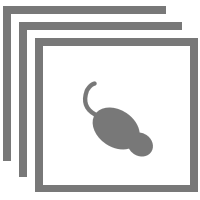 ANY-box
ANY-box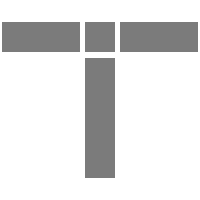 T-maze
T-maze Zero maze
Zero maze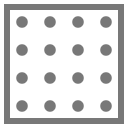 Hole board
Hole board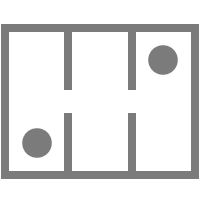 Sociability cage
Sociability cage OPAD
OPAD RAPC
RAPC Waterwheel forced swim test
Waterwheel forced swim test Thermal gradient ring
Thermal gradient ring Operon
Operon Activity Wheel
Activity Wheel Full ANY-maze licence
Full ANY-maze licence Other licence types
Other licence types Developing countries licence
Developing countries licence Contact support
Contact support Support Policy
Support Policy FAQs
FAQs Guides
Guides Downloads
Downloads Send us files
Send us files Activate a licence ID
Activate a licence ID Contact us
Contact us Blog
Blog About
About Testimonials
Testimonials Privacy Policy
Privacy Policy
